Coast guard
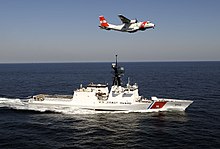
USCG National Security Cutter USCGC Bertholf (WMSL-750) and a EADS HC-144 Ocean Sentry

Russian Coast Guard ship #183 Volga
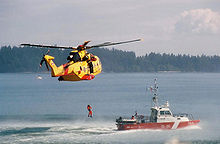
A CH-149 Cormorant training with a Canadian Coast Guard cutter

A Chinese Coast Guard ship participating in an international exercise
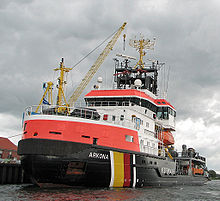
Multi-purpose vessel Arkona of the German Federal Coast Guard
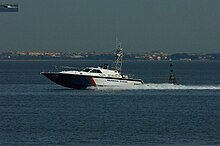
A Portuguese National Republican Guard Coastal Control Unit surveillance boat of the LVI type
A coast guard or coastguard is a maritime security organization of a particular country. The term implies widely different responsibilities in different countries, from being a heavily armed military force with customs and security duties to being a volunteer organization tasked with search and rescue functions and lacking any law enforcement powers. However, a typical coast guard's functions are distinct from typical functions of both the navy (a pure military force) and a transportation police (a civilian law enforcement agency).
Contents
1 History
2 Role
3 Type and role by country
3.1 Argentina
3.2 Australia
3.2.1 Federal
3.2.2 State
3.2.3 Community
3.3 Bangladesh
3.4 Barbados
3.5 Bosnia and Herzegovina
3.6 Brazil
3.7 Canada
3.8 China
3.9 Croatia
3.10 Cyprus
3.11 France
3.12 Georgia
3.13 Germany
3.14 Greece
3.15 Haiti
3.16 Hong Kong
3.17 Iceland
3.18 India
3.19 Indonesia
3.20 Ireland
3.21 Isle of Man
3.22 Italy
3.23 Japan
3.24 Jersey
3.25 South Korea
3.26 Malaysia
3.27 Mexico
3.28 Netherlands
3.29 Caribbean Netherlands
3.30 New Zealand
3.31 Norway
3.32 Pakistan
3.33 Peru
3.34 Philippines
3.35 Poland
3.36 Portugal
3.37 Russia
3.38 Singapore
3.39 Spain
3.39.1 Galicia
3.40 Sri Lanka
3.41 Sweden
3.42 Taiwan (Republic of China)
3.43 Trinidad and Tobago
3.44 Turkey
3.45 Ukraine
3.46 United Kingdom
3.46.1 Scotland
3.47 United States
3.48 Uruguay
3.49 Vietnam
4 See also
5 References
6 External links
History
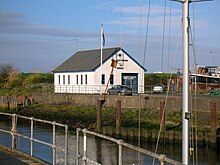
The HM Coastguard station at Girvan, Ayrshire, Scotland
The predecessor of the modern Her Majesty's Coastguard of the United Kingdom was established in 1809 as the Waterguard, which was originally devoted to the prevention of smuggling as a department of the HM Customs and Excise authority. At the time, due to high UK taxation on liquors such as brandy, and on tobacco, etc., smuggling in cargoes of these from places such as France, Belgium, and Holland, was an attractive proposition for many, the barrels of brandy and other contraband being landed from the ships on England's beaches at night from small boats and later sold-on for profit, as later depicted in the Doctor Syn series of books by Russell Thorndike. The Coastguard was also responsible for giving assistance to shipwrecks.
Each Waterguard station was issued with a Manby mortar, which had been invented by Captain George William Manby in 1808. The mortar fired a shot with a line attached from the shore to the wrecked ship and was used for many years. This began the process through which the Coastguard assumed a life saving role. In 1821 a committee of inquiry recommended that responsibility for the Preventative Waterguard be transferred to the Board of Customs. The Treasury agreed and (in a memorandum dated 15 January 1822) directed that the preventative services, which consisted of the Preventative Water Guard, cruisers, and riding officers should be placed under the authority of the Board of Customs and in future should be named the "Coastguard". In 1845 the Coastguard was subordinated to the Admiralty.[1]

The Cape Hatteras Life-Saving Station, North Carolina, in use from the mid-19th century
In 1829 the first UK Coastguard instructions were published and dealt with discipline and directions for carrying out preventative duties. They also stipulated that, when a wreck took place, the Coastguard was responsible for taking all possible action to save lives, to take charge of the vessel and to protect property.[2]
In the United States, the United States Coast Guard was created in 1915 by the merger of two other federal agencies. The first, the United States Revenue Cutter Service, was a maritime customs enforcement agency that also assumed a supporting role to the United States Navy in wartime. The second, the United States Life-Saving Service, was formed in 1848 and consisted of life saving crews stationed at points along the eastern seaboard. The Coast Guard later absorbed the United States Lighthouse Service and the Bureau of Navigation and Steamboat Inspection.
Role
Among the responsibilities that may be entrusted to a coast guard service are:
- search and rescue,
- enforcement of maritime law,
- safety of vessels,
- maintenance of seamarks, and
border control.
During wartime, some national Coast Guard organisations might have a role as a naval reserve force with responsibilities in harbor defenses, port security, naval counter-intelligence and coastal patrols.
The Coast Guard may, varying by jurisdiction, be part of a country's military, a law enforcement agency, or a search and rescue body. For example, the United States Coast Guard is a military branch with a law enforcement capacity, whereas the United Kingdom's Her Majesty's Coastguard (HMCG) is a civilian organisation whose primary role is search and rescue.[3] Most coast guards operate ships and aircraft including helicopters and seaplanes that are either owned or leased by the agency in order to fulfil their respective roles.
Some coast guards, such as the Irish Coast Guard, have only a very limited law enforcement role, usually in enforcing maritime safety law, such as by inspecting ships docked in their jurisdiction.[4] In cases where the Coast Guard is primarily concerned with coordinating rather than executing rescue operations, lifeboats are often provided by civilian voluntary organisations, such as the Royal National Lifeboat Institution in the United Kingdom, whilst aircraft may be provided by the countries' armed forces, such as the search and rescue Sea Kings operated by the Royal Air Force and Royal Navy, in addition to any of the HMCG's own helicopters.
Type and role by country
The following lists a select number of Coast Guards around the world, illustrating the varied roles they play in the respective governments and the countries they operate in:
Argentina
The Argentine Naval Prefecture, in Spanish Prefectura Naval Argentina or PNA, is a service of the Argentine Republic's Security Ministry charged with protecting the country's rivers, lakes and maritime territory. It therefore fulfills the functions of other countries' coast guards, and furthermore acts as a gendarmerie force policing navigable rivers and lakes. They belonged to the Ministry of Defence until the 1980s, and the corps' highest official was a Navy rear-admiral. They have since been transferred to the Ministry of Interior and, more recently, to the newly created Ministry of Security. However, in the case of armed conflict, they can be put under the Navy's command.
Australia
Responsibilities for traditional coast guard duties in Australia are distributed across various federal, state and community volunteer agencies.
Federal
- The Maritime Border Command is the de facto coast guard of Australia. The Maritime Border Command is a joint unit of the Australian Defence Force (the Royal Australian Navy Patrol Force and the Royal Australian Air Force Surveillance and Response Group) and the Australian Border Force (Marine Unit and Coastwatch aircraft). It is responsible for border protection in the exclusive economic zone of Australia and its 19,650 kilometres of coastline and issues such as illegal fishing and exploitation of natural resources, maritime terrorism and piracy, biosecurity threats, and marine pollution.
- The Australian Maritime Safety Authority is responsible for maritime safety and seaworthiness of Australian and foreign vessels in Australian waters including compulsory pilotage, aids to navigation, the Australian Rescue Coordination Centre and coordination of search and rescue operations, and management of Australia's international maritime obligations.
- The Australian Fisheries Management Authority is responsible for the management and sustainable use of fisheries resources and for combating illegal fishing activities in the Australian Fishing Zone.
- The Australian Federal Police supports the Maritime Border Command and particularly the Australian Border Force with criminal investigations, law enforcement and national security matters.
- The Office of Transport Security has various responsibilities for maritime security.
State
Each State Government also has agencies with coast guard responsibilities. For example, in Queensland, Maritime Safety Queensland is responsible for maritime safety and the Queensland Police Service has a water police unit for law enforcement along the coastline, in waterways, and for Queensland islands.
Community
In addition, there are several private volunteer coast guard organizations, the two largest organizations being the Royal Volunteer Coastal Patrol (established in 1937) and the Australian Volunteer Coast Guard (established in 1961). These volunteer organizations have no law enforcement powers, and are essentially auxiliary Search and Rescue services. In NSW these two organisations have joined to become Marine Rescue in 2009.
Bangladesh
The Bangladesh Coast Guard (Bengali transliteration: বাংলাদেশ কোস্ট গার্ড; translated from English: বাংলাদেশ উপকূল রক্ষক); BCG is the maritime law enforcement force of Bangladesh. It is a paramilitary force which is under the jurisdiction of the Ministry of Home Affairs. Its officers are transferred from the Bangladesh Navy. The Bangladesh Coast Guard also performs the duty of maritime border security of Bangladesh. The headquarters is located in Dhaka, Bangladesh. Currently the coast guard has 3,339 personnel[5]
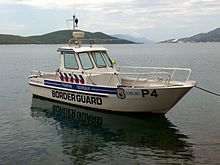
Bosnia and Herzegovina Granična policija surveillance boat (unit P4)
Barbados
Bosnia and Herzegovina
Having 18 kilometres of coastline only, Bosnia Herzegovina does not have a force dedicated to defend its coast. The duty of patrolling its coastline falls to the Granična policija (Border Police).
Brazil
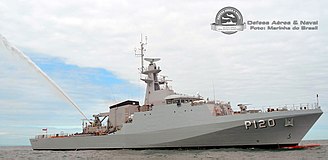
Brazilian ship used to protect Brazilian borders
In addition to the roles of a traditional navy, the Brazilian Navy also carries out the role of organizing the merchant navy and other operational safety missions traditionally conducted by a coast guard. Other roles include: Conducting national maritime policy, and implementing and enforcing laws and regulations with respect to the sea and inland waters.
Canada
The Canadian Coast Guard (CCG) is a civilian service under the Department of Fisheries and Oceans responsible for patrolling the world's longest coastline of 243,042 km (~151,000 mi).[6]
The CCG holds responsibility for all marine search and rescue throughout Canada. The CCG coordinates search and rescue operations with the Canadian Armed Forces, Royal Canadian Mounted Police, and other organizations. The CCG maintains and operates seamarks, coastal light stations, vessel traffic services, marine pollution response services, marine communications systems, and provides icebreaking services. The CCG also operates all Federal scientific research and hydrographic survey vessels. To accomplish these tasks, the CCG has a sizable fleet of vessels and aircraft, all serviced from various bases and smaller stations located on three coasts (Atlantic, Arctic, Pacific) and the Great Lakes and St. Lawrence River.[7]
The Canadian Coast Guard College is located near Sydney, Nova Scotia.
China
The People’s Republic of China used to operate several coast guard agencies. In March 2013, China announced it would combine the assets of four separate maritime law enforcement agencies to form a unified Coast Guard, administrated by the State Oceanic Administration[8] The new Coast Guard has been in operation since July 2013.[9] Since March 21, 2018, it has been administrated by the People’s Armed Police again, bringing it closer to the formal status of a military force.[10]
The current China Coast Guard (Simplified Chinese: 中国海警) serves as a coordinating body for maritime search and rescue in the territorial waters of the People’s Republic of China. The China Coast Guard was previously a maritime branch of the Public Security Border Troops, a paramilitary police force under the leadership of the Ministry of Public Security (MPS). Since 2013, it has been administered by the State Oceanic Administration. On March 2018, it has again been placed under the leadership of the People’s Armed Police, which is under the direct command of the Central Military Commission.
The former China Maritime Safety Administration (Chinese: 中国海事局) was a government agency which coordinated maritime search and rescue in the territorial waters of the People’s Republic of China (PRC). The CMSA was part of the Ministry of Transport.
The former China Marine Surveillance (CMS), created on October 19, 1998, was a paramilitary maritime law enforcement agency of the State Oceanic Administration of the PRC. The force was responsible for enforcing laws and order within China’s territorial waters, exclusive economic zones (EEZ), and shores; protecting the maritime environment, natural resources, navigation aids and other facilities; and carrying out maritime surveys. In emergencies, these forces could also be deployed for other missions such as search and rescue.
The former China Fisheries Law Enforcement Command (FLEC)(Chinese: 中国渔政), an organ of the Fisheries Management Bureau under the PRC Ministry of Agriculture, was responsible for the enforcement of laws concerning fishing and maritime resources within the PRC’s territorial waters and exclusive economic zones (EEZ). The FLEC’s responsibilities included protecting Chinese fishing vessels and personnel, resolving disputes in fishing activities, preventing illegal fishing, and protecting maritime resources.
Croatia
The Croatian Coast Guard (Croatian: Obalna straža Republike Hrvatske) is a division of the Croatian Navy responsible for protecting the interests of the Republic of Croatia at sea. The Croatian Navy is composed of classical naval forces structured into a flotilla and the Coast Guard that solely consists of ships with peacetime duties, e.g. protection of ecology, fishing, control of tankers, ballast waters, combat against terrorism, trafficking of people, narcotics, and similar.[11]
On September 13, 2007, the Croatian Parliament passed a bill establishing the Croatian Coast Guard. The Coast Guard’s mission is protect sovereign rights and carry out Croatia’s jurisdiction in the Ecological and Fisheries Protection Zone, the continental shelf and the high seas. The Coast Guard will also monitor vessels sailing in the Croatian territorial waters. If vessels are caught violating Croatian or international regulations and disregard warnings by the Coast Guard, Coast Guard ships and airplanes are authorized to pursue them and if necessary open fire, while taking care not to jeopardize the lives of the vessel’s crew.
Under the law, the commander of the Coast Guard is a Navy officer who is appointed and relieved of duty by the President of the Republic at the government’s proposal.[12]
Cyprus

Cyprus Port and Marine Police jet FPB (Fast sea Patrol Boat)
The Cyprus Port and Marine Police (Greek Λιμενική και Ναυτική Αστυνομία - Limeniki kai Nautiki Astinomia) fulfills the functions of other countries' coast guards for the Republic of Cyprus. Cyprus is an island country in the Eastern Mediterranean with almost 40% of its territory under occupation after a Turkish military Invasion. Due to the country's geopolitical situation, size, the recent discovery in 2011 of the Aphrodite gas field in its Exclusive Economic Zone and Cyprus Police being the main national Law enforcement agency, the duties and responsibilities of the Cyprus Port and Marine Police are many and sometimes complex. It is a unit of the Cyprus Police, which resides under the Ministry of Justice and Public Order (Cyprus). However it can support the Cyprus Navy in wartime which resides under the Ministry of Defence. It is staffed by Police Officers which can be transferred to and from other units and agencies of the Cyprus Police and are tasked with the primary mission of policing the country's sea borders and the law enforcement of the waters around it. The unit is equipped with patrol boats and radars but it does not operate its own helicopters. Instead, it operates in combination with the aerial unit of the Cyprus Police, the Cyprus Police Aviation Unit. Main roles include law enforcement against illicit activities such as smuggling (due to the fact that although the Customs and Excise Department is a separate agency under the Ministry of Finance, it does not have an operational or tactical team of its own), terrorism, piracy, illegal fishing, Illegal drug trade, illegal immigration and is also assigned with Search and Rescue (SAR) duties. For counter-terrorism and anti-piracy operations, the units operate in combination with the Special Anti-Terrorist Squad which is part of the Emergency Response Unit of the Cyprus Police. Although the prominent agencies responsible for all Search and Rescue operations are conducted by Cyprus Police Units, the agency responsible to organize the SAR system, to co-ordinate, to control and direct SAR operations in the region that the Republic of Cyprus is responsible for (which coincides with the Nicosia FIR) is the Cyprus Joint Rescue Coordination Center or JRCC Larnaca, which is an independent agency of the Ministry of Defence.
France
In the French Republic, Affaires maritimes is the closest organization to a coast guard. In each region, a naval admiral, called préfet maritime, is in charge of coordination of all state services for action at sea (Navy, Affaires maritimes, gendarmerie, customs, fisheries surveys ...). The charity, Société Nationale de Sauvetage en Mer, provides most life saving duties at the local level.
Georgia
The Georgian Coast Guard is the maritime arm of the Georgian Border Police, within the Ministry for Internal Affairs. It is responsible for the maritime protection of the entire 310 km (190 mi) coastline of Georgia, as well as the Georgian territorial waters. The primary missions of the service are administration of the territorial waters, marine pollution protection, maritime law enforcement, search and rescue, port security and maritime defense. The former Georgian Navy was absorbed into the Coast Guard in 2009.
The Georgian Navy (Georgian Naval Forces; Georgian: საქართველოს სამხედრო საზღვაო ძალები, sak’art’velos samkhedro-sazghvao dzalebi) was a branch of the Georgian Defense Ministry armed forces until 2009, when it was merged with the Coast Guard and transferred to the Ministry for Internal Affairs. Before the 2008 South Ossetia war, the Georgian Navy consisted of 19 vessels and 531 personnel of which 181 were officers, 200 NCOs, 114 conscripts and 36 civilians.[citation needed]
The headquarters and a principal Coast Guard base are located at the Black Sea port of Poti. A second smaller base is in Batumi, Adjaria. Besides the Poti-based force, the Coast Guard also includes a special counter-terrorist Detachment. Maritime surveillance radar stations are maintained at Anaklia, Poti, Supsa, Chakvi, and Gonio, providing coverage of all territorial seas.
The current (2012) commander of the Georgian Coast Guard is Captain 2nd Rank Lasha Kharabadze.[needs update]
Germany
The German Federal Coast Guard, known as the Küstenwache, is both a civilian service and a law enforcement organisation, staffed with both police officers and certain civilians from the various German federal agencies associated with maritime administration with responsibility for the coordination of all law enforcement activities within its jurisdiction in the Federal Republic of Germany.[13]
Greece
The Hellenic Coast Guard (Greek Λιμενικό Σώμα-Ελληνική Ακτοφυλακή - Limeniko Soma-Elliniki Aktofylaki - lit. "Harbor Corps-Hellenic Coast Guard") is the national coast guard of the Republic of Greece. It is a paramilitary organization that can support the Hellenic Navy in wartime, but resides under separate civilian control in times of peace. It was founded in 1919 by an Act of Parliament and the legal framework for its function was reformed in 1927.
Haiti
The Haitian Coast Guard is an operational unit of the Haitian National Police. It is one of the few law enforcement organisations in the world to combine water policing and coast guard duties while remaining as a policing unit. It operates primarily as a law enforcement agency, with secondary responsibilities in search and rescue.
Hong Kong
In Hong Kong, law enforcement duties are carried out by the Marine Region of the Hong Kong Police Force and the Customs and Excise Department (Ports and Maritime Command of the Boundary and Ports Branch). The Hong Kong Maritime Rescue Co-ordination Centre (HKMRCC) co-ordinates search and rescue vessels, aircraft and other resources of the Fire Services Department, Government Flying Service, Marine Department and the Marine Police.
Iceland
The Icelandic Coast Guard has primarily been a law enforcement organisation but is also in charge of national defences. It has also involved with the Republic of Iceland's contributions to expeditionary operations and conducted military exercises. For example, Operation Enduring Freedom and Northern Challenge.[14]
India

Indian Coast Guard Vishwast-class offshore patrol vessel
In the Republic of India, the Indian Coast Guard is an armed force of the union, under the ministry of defence and, in contrast with some coast guard units, resembles a naval coastal defence force. It has responsibility for search and rescue, enforcement of maritime law- anti-smuggling, immigration and shipping regulations- and protecting the country's maritime and offshore resources[15]
Indonesia
The Indonesian Maritime Security Agency (Indonesian: Badan Keamanan Laut Republik Indonesia – BAKAMLA) is a maritime patrol and rescue on the Republic of Indonesia territorial water. BAKAMLA is a non-ministerial government institution which reports directly to the President through Coordinating Ministry for Political, Legal, and Security Affairs. BAKAMLA's duty is to conduct security and safety patrols in the territorial waters of Indonesia and the jurisdiction of Indonesia. Previously BAKAMLA was a non-structural institution called the Coordinating Agency for the Security of the Republic of Indonesia (Indonesian: Badan Koordinasi Keamanan Laut Republik Indonesia – Bakorkamla). The agency is not part or associated with the Indonesian National Armed Forces, although its top-ranking leadership are handpicked from the Indonesian Navy. BAKAMLA and the Indonesian Navy, however, often conduct exercises and joint-operation together. While during search-and-rescue operations, BAKAMLA also conduct joint-operations with the National Search and Rescue Agency.
Ireland
The Irish Coast Guard (IRCG) makes up one arm of the Maritime Safety Services, the other being the Maritime Safety Directorate. Both arms are due to merge into a new "one stop shop" agency for all maritime safety matters.
The purpose of the Irish Coast Guard is:
To reduce the loss of life within the Irish Search and Rescue Region and on rivers, lakes and waterways and to protect the quality of the marine environment within the Irish Pollution Responsibility Zone, Harbours and Maritime Local Authority areas and to preserve property.
To promote safety standards, and by doing so, prevent, as far as possible, the loss of life at sea and on inland waters and other areas, and to provide an effective emergency response service.
Isle of Man
The Isle of Man is a Crown dependency located in the Irish Sea between Ireland and the United Kingdom. It is not part of the United Kingdom, but historically relied upon the U.K. Coastguard. However, the U.K. Coastguard withdrew in 1988, and the Isle of Man Government formed its own Coastguard in 1989. Its key functions are coastal patrol, pollution control, and shore-based search and rescue. It also co-operates with other agencies as part of the Isle of Man Inland Search and Rescue Group. It maintains the Isle of Man's Marine Operations Centre (control room), but it has no aircraft, and contracts air-sea rescue to the U.K. Coastguard.
Italy
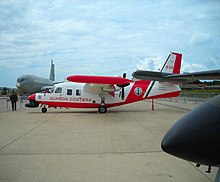
Piaggio P.166 aircraft used by Italian Coast Guard
In the Republic of Italy, the Guardia Costiera is part of the Italian Navy under the Ministry of Infrastructure and Transport. They have responsibility for enforcement of shipping and maritime safety regulations, as well as performing search and rescue duties[16]
Japan
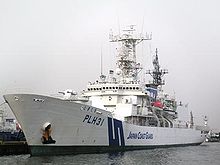
Japan Coast Guard Shikishima (PLH 31) is the largest patrol vessel in the world.
In Japan, the Japan Coast Guard is under the oversight of the Ministry of Land, Infrastructure, Transport and Tourism, and is responsible for the protection the coast-lines and islands of Japan.
Jersey
The Island of Jersey Coastguard is the coastguard service of the Government of Jersey, an independent Crown dependency located near to northern France. Its main responsibilities are safety at sea, maritime security and law enforcement, search and rescue services (with partner agencies), and protection of the marine environment. "Channel Islands AirSearch" works with the Coastguard service on search and rescue operations, and therefore the Coastguard does not maintain its own aircraft.
South Korea

A Kamov Ka-32 of the Republic of Korea Coast Guard
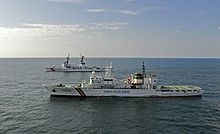
Korea Coast Guard vessel training with the US Coast Guard
The Korea Coast Guard (Korean: 해양경찰청; Hanja: 海洋警察廳, Revised Romanization: Haeyang-gyeongchal-cheong, Maritime Police Agency) is responsible for maritime safety and control off the coast of the Republic of Korea/South Korea. The KCG is an external branch of the R.O.K.'s Ministry of Maritime Affairs and Fisheries during peacetime.
Malaysia
In Malaysia, the Malaysian Maritime Enforcement Agency (MMEA) or Malaysia Coast Guard is part of the Malaysian Civil Service and is under the Prime Minister's Department.
The Agency is headed by a[Director General] who is appointed by the Yang Di Pertuan Agong (King) on the advice of the Prime Minister while other personnel are appointed by the Public Service Commission.
In times of war, crisis or emergency, the Agency may be placed under the command of the Royal Malaysian Armed Forces. It was formed to combat the rise of piracy in the Strait of Malacca ("The Straits"). Personnel often work very closely with the Royal Malaysian Navy and Royal Malaysian Air Force. The Coast Guard operates a Special Forces Commando or STAR (Special Task and Rescue) unit, which was absorbed from the Navy's PASKAL and Air Force's PASKAU. The agency utilizes its resources in a maritime law enforcement and search and rescue capacity.[17]
Mexico
The Maritime Search and Rescue (Búsqueda y Rescate Marítimo) is a unit of the Mexican Navy. Its primary mission is search and rescue operations within 50 miles (80 km) of the Mexican coastline.
Netherlands
The Kingdom of The Netherlands Coastguard (Nederlandse Kustwacht) is a national organization responsible for various services along The Netherlands' ocean coastline (mainly search and rescue services).
Caribbean Netherlands
The Dutch Caribbean Coastguard (Kustwacht Caraïbisch Gebied) is the coast guard of the Kingdom of the Netherlands in the Caribbean, providing search & rescue, and maritime law enforcement in Aruba, Curaçao, Sint Maarten, Bonaire, Sint Eustatius and Saba.
New Zealand
The Royal New Zealand Coastguard is a civilian volunteer charitable organisation,[18] providing search and rescue services to coastal waterways and some lakes in New Zealand. Smaller incidents are coordinated by the New Zealand Police, who may call on the services and resources of the coastguard. Larger incidents are managed by the Rescue Coordination Centre New Zealand (RCCNZ), with support from the Royal New Zealand Defence Force.[19]
Norway

Norwegian Coast Guard vessel KV Nordkapp off Svalbard
The Royal Norwegian Coast Guard, or Kystvakten in Norwegian, is a part of the Royal Norwegian Navy, but has separate vessels, many of which are purpose-built. Coast guard vessels have the prefix KV. Four of these vessels are capable of embarking one or more helicopters. Norway's exclusive economic zone, the Coast Guard's area of responsibility, is about 2.2 million square kilometers, one of the largest in Europe.
Pakistan
In Islamic Republic of Pakistan, there are two units operated as Coast Guards—the Maritime Security Agency (MSA) under the Pakistan Navy and the Pakistan Coast Guard. The MSA is a military force operated by the Navy under the direction of Ministry of Defence in its right. The Pakistani Coast Guard are placed under the Pakistan Army and has responsibilities for protecting coastal and shores of Karachi while the MSA has entire area of responsibility of the Republic of Pakistan's coastlines in terms of strategic security, as well as law enforcement within the country's exclusive economic zone.[20]
Peru
Philippines
In the Republic of the Philippines, the Philippine Coast Guard (PCG) is a maritime law enforcement agency operating under the Department of Transportation of the Republic of the Philippines government. It is tasked with the broader enforcement of maritime laws, especially against smuggling, illegal fishing, drug trafficking, and piracy. It patrols the country's 36,289-kilometer coastline and hundreds of islands, and is also involved in maritime search and rescue (SAR) missions, as well as the protection of the marine environment.[21]
Poland
In Poland, the law enforcement coast guard role is performed by the Maritime Branch of the Polish Border Guard (Morski Oddział Straży Granicznej). It is part of the Polish Border Guard. Search and Rescue (SAR) role of coast guard is performed by Maritime Search and Rescue Service (Morska Służba Poszukiwania i Ratownictwa).
Portugal

A Portuguese Navy's Centauro-class patrol boat, one of its assets employed in the coast guard role under the Portuguese National Maritime Authority
In Portugal, the coast guard role is performed by several government agencies that, together, form the Sistema de Autoridade Marítima (Maritime Authority System) or SAM. The SAM includes the Portuguese Navy, the National Republican Guard (GNR), the Portuguese Air Force, the Border and Immigration Service (SEF), the Civil Protection Authority, the National Medical Emergency Institute and the Criminal Investigation Police (PJ).
The Autoridade Marítima Nacional (National Maritime Authority) or AMN is the branch of the Portuguese Navy responsible for its coast guard role. The function of AMN is performed by the Chief of Staff of the Navy himself, supported in this role by the Directorate of the Maritime Authority, which includes the Maritime Police, the Lifeguard Institute, the Lighthouse Department and the several harbourmasters. Besides the specific assets of the Directorate of Maritime Authority entirely dedicated to the coast guard role, the AMN also has at its disposal the other Portuguese Navy's assets that can be used both for military and public service missions.
The vessels operated within the SAM include the Maritime Police patrol boats, the Lifeguard Institute lifeboats, the harbourmasters harbour boats, the GNR Coastal Control Unit' surveillance boats and the Portuguese Navy's naval ships. The aircraft operated within the SAM include fixed-wing aircraft from the Portuguese Air Force and helicopters from the Navy, the Air Force and the Civil Protection Authority.
Russia
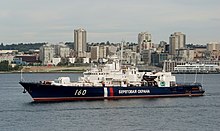
Russian Border Guard vessel Vorovskiy in Seattle
Russia's Coast Guard (Береговая охрана России) operates under the auspices of the Border Guard Service of Russia (itself a branch of the FSB Federal Security Service). Its remit encompasses the twelve-mile limit of all Russian territorial and coastal waters and, being equipped with frigates, corvettes, fast patrol boats, hydrofoils, helicopters, and light aircraft, it has considerable combat capability on behalf of the continent-wide Russian Federation.
For inland waters operations Russia has the National Guard Naval Service Corps, established in 1978, while inland waters SAR operations are also under the purview of the Ministry of Emergency Situations.
Singapore
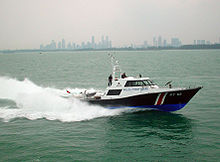
A third generation patrol craft of the Police Coast Guard conducting a sea-rescue demonstration off the southeastern coast of Singapore
In Singapore, the Police Coast Guard (PCG) is an operational department of the Singapore Police Force. Functions of the coast guard were transferred from the Republic of Singapore Navy to what was then the Marine Police in February 1993.[22] The Marine Police was thus restructured and renamed as the Police Coast Guard, one of the few law enforcement organizations in the world to combine water policing and coast guard duties while remaining as a policing unit. It operates primarily as a law enforcement agency, with secondary responsibilities in search and rescue.[23]
Spain

An AW139 helicopter of Spain's Sociedad de Salvamento y Seguridad Marítima
The Kingdom of Spain operates several coast guard agencies.
The Sociedad de Salvamento y Seguridad Marítima, also known as Salvamento Marítimo, or by its acronym SASEMAR, is the body in charge of maritime traffic control, safety and rescue operations, as well as protection of the maritime environment, but lacks any law enforcement responsibilities. The agency runs 20 rescue coordination centres (RCC), employs a staff of 1500 and operates a fleet of 19 vessels, 54 boats, 8 helicopters and 4 aircraft.
Border protection functions in the Kingdom of Spain are carried out by the Servicio Marítimo de la Guardia Civil, with a staff of 1100 and a fleet of 67 patrol vessels and speedboats. Maritime customs functions are the responsibility of the Servicio de Vigilancia Aduanera with 13 aircraft and a surface fleet of 2 high seas cutters; 18 high speed patrol vessels; and 21 medium-sized and smaller patrol vessels.
Salvamento Marítimo operates in the four international SAR areas assigned to Spain: Atlántico, Canarias, Estrecho and Mediterráneo, covering a combined extension of 1.5 million square kilometers. During a maritime emergency, Salvamento Marítimo is responsible for the coordination of other possible responders, like the Spanish Navy or the Servicio Aéreo de Rescate,[24] that comprises squadrons 801, 802 and 803 of the Spanish Air Force. Coordination on land, sea and air are made with the North Atlantic Treaty Organization (NATO), and cooperative European Union
Galicia
The autonomous community of Galicia has its own separate coast guard service, the Servizo de Gardacostas de Galicia or simply Gardacostas de Galicia. It is the Galician Government agency responsible for coastal and fisheries surveillance; maritime search and rescue; and protection of the sea environment. The Gardacostas de Galicia operates a fleet of more than 20 vessels and three helicopters, from the bases of Viveiro, Ferrol, A Coruña, Muxía, Porto do Son, Ribeira, Vilagarcía de Arousa, Pontevedra and Vigo.
The Gardacostas de Galicia was created in 2004, by the amalgamation of the former Servizo de Vixilancia Pesqueira (Galician Fisheries Surveillance Service) and the Servizo de Busca e Salvamento (Galician Search and Rescue Service).
Sri Lanka
In Sri Lanka, until 2009 a Coast Guard Unit existed under the Ministry of Fisheries and Aquatic Resources, responsible for fishery and natural resource protection coastal areas. A new Department of Coast Guard was created under the Department of Coast Guard Bill presented to parliament in 2009. The department would be under the purview of the Ministry of Defense and be staffed by civilian personal. The department's responsibilities include search and rescue, law enforcement within the country's Exclusive economic zone, conducting anti-smuggling and anti-immigration operations, suppression of terrorist activities in territorial waters of Sri Lanka.[25]
Sweden

Swedish coast guard conducting an alcohol test
The Royal Swedish Coast Guard (Swedish: Kustbevakningen) is a Swedish civilian government agency with combination of police tasks, border control, maritime rescue and environmental control. Coast Guard officers carries the same equipment and similar uniforms to regular Swedish police officers.
Tasks:
- maritime surveillance and other control and inspection tasks as well as environmental cleanup after oil spills at sea
- co-ordinate the civilian needs for maritime surveillance and maritime information
- follow international development within the field and take part in international efforts to establish border controls, law enforcement at sea, environmental protection at sea and other maritime surveillance tasks.
The Royal Swedish Coast Guard carries out some of its surveillance by air (from its base in Skavsta near Stockholm), and some on ice and snow (from its Luleå station). It also has marine duties in Lake Vänern, Europe's third largest lake, operating out of Vänersborg.
Taiwan (Republic of China)
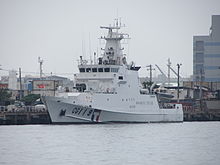
Coast Guard Administration (Taiwan) patrol vessel
The Coast Guard Administration is both a military and a law enforcement organization. The CGA is considered a civilian law enforcement agency under the administration of the Executive Yuan, though during wartime it may be incorporated as part of the ROC military. Its primary roles are ensuring the safety and security of territorial waters and coordinating search and rescue efforts.[26]
The CGA includes a Maritime Patrol Directorate General and a Coast Patrol Directorate General. Officers of the Maritime Patrol Directorate General are law enforcement officials, but officers of the Coast Patrol Directorate General are considered soldiers who have partial law-enforcement power.
Trinidad and Tobago
The Trinidad and Tobago Coast Guard (TTCG) is the maritime division of the Trinidad and Tobago Defence Force. It is within the government portfolio of the Ministry of National Security. The Commanding Officer of the Coast Guard reports to the Chief of Defence Staff. The TTCG is responsible surveillance, search and rescue, fisheries enforcement, pollution enforcement, and counter-narcotics operations for maritime jurisdiction of Trinidad and Tobago.[27]
Turkey

Patrol boat of the Turkish Coast Guard
The Turkish Coast Guard of the Republic of Turkey (Turkish: Sahil Güvenlik Komutanlığı) is a branch of the Turkish Armed Forces and was initially founded in 1859. During peace time, it is under the command of the Ministry of Interior. However, during war or emergency time, it falls under the command of the Turkish Navy. On July 13, 1982, it was assigned to the Turkish Gendarmerie becoming both a military and a law enforcement service. Finally, the organization obtained its current form on January 1, 1985.[28]
The Coast Guard is responsible for enforcement of Turkish maritime law and controlling of the Republic of Turkey's coasts in the responsibility area. It is also the main search and rescue coordination authority for the Turkish coastal zone. The Coast Guard consists of four area commands, as the Black Sea, the Sea of Marmara and adjacent straits, the Aegean Sea, and the Mediterranean Sea.[28]
The Turkish Coast Guard maintains a fleet of coastal patrol ships and small craft, as well as helicopters and fixed-wing aircraft.[29]
Ukraine
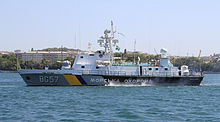
Stenka-class patrol boat BG57 Mykolaiv
Ukrainian Sea Guard is the coast guard service of Ukraine, subordinated to its Border Guard Service, the local successor of the Soviet Border Troops Naval Units that have been similarly responsible for coast guard tasks. However, there were some interchanges in units, ships and personnel between Sea Guard and the Ukrainian Navy. Operates four sea guard detachment; a sea guard cutters division in Mariupol; a special-purpose sea guard cutters division in Yalta; and a riverine Dnieper sea guard cutters division in Kiev. Sea guard administration is split between the Azov-Black seas regional administration in Simferopol and the Southern regional administration in Odessa.
Service persons of the Sea Guard wear either the black uniform similar to Ukrainian Navy, but decorated with some green elements (traditional for border guard), or a common uniform of the Border Guard.
United Kingdom
In the United Kingdom, Her Majesty's Coastguard fulfill six of the nine functions required by the IMO, Search and Rescue, Pollution Response, Vessel Traffic Management, Maritime Safety, Accident and Disaster Response and Maritime Security. The remaining three IMO functions, Customs / Border Control, Fisheries Control and Law Enforcement are undertaken by other agencies in the UK. HM Coastguard has no role in the maintenance of seamarks which is instead the responsibility of Trinity House, the Northern Lighthouse Board (in Scotland) and the Commissioners of Irish Lights (in Northern Ireland).
HM Coastguard does not possess any of its own lifeboats but does have several workboats (i.e. MCA Falcon) which are sometimes used to patrol an area, or to transfer agency ship surveyors to a vessel; the workboats are not lifeboats, instead they are provided by the volunteer Royal National Lifeboat Institution or other Independent Units. HMCG through its parent agency (the MCA) wet leases commercial helicopters—mainly Sikorsky S-92s and AgustaWestland AW139s—and tugs to provide search and rescue cover in certain areas. It does, however, maintain a number of search, cliff and mud rescue teams as well as some inshore rescue boats and is a coordinating body and public face for the maritime search and rescue services. It is part of the Maritime and Coastguard Agency, which in itself is an executive agency of the Department for Transport. Cooperation is made with the Royal Navy, the Royal Air Force and the all volunteer National Coastwatch Institution, which mans many of the vacated former Coastguard Watch-houses along the coast.
HM Coastguard station at Girvan Scotland

AgustaWestland AW189 helicopter of the UK Coastguard arrives at the 2018 RIAT, England
Scotland
The Scottish Fisheries Protection Agency (SFPA) is responsible for both deterring illegal fishing in Scottish waters, as well as monitoring the compliance of the fisheries industry in Scotland with the relevant Scottish and European Union laws on fisheries.
United States
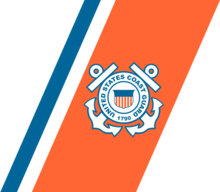
USCG racing stripe

National Security cutters, the USCGC Bertholf and USCGC Waesche, cruise together.
Formed in 1915 by the merger of the Revenue Cutter Service (est. 1790) and the Lifesaving Service (est. 1848), and later absorbing other federal agencies, the U.S. Coast Guard (USCG) is a military service, a law enforcement agency, and regulatory agency. It is one of the seven uniformed services of the United States and one of the five services of the United States Armed Forces. Its role includes enforcement of U.S. maritime law, coastal defense, search and rescue, environmental protection, and regulation of maritime industries.[30][31] In terms of size, the U.S. Coast Guard by itself is the world's 12th largest naval force.[32]
During peacetime the USCG falls under the administration of the United States Department of Homeland Security (previously the U.S. Department of Transportation, 1967–2003, and the United States Department of the Treasury, 1915–1967). During wartime, the USCG may, at the direction of the President of the United States, report to the Secretary of the Navy; its resources, however, are integrated into U.S. military operations in wartime (see 14 U.S.C. §§ 3–4).
As of 2017[update], the Coast Guard had over 42,000 men and women on active duty, 8,100 reservists, 32,000 auxiliarists, and over 7,100 full-time civilian employees.[31] The Coast Guard maintains an extensive fleet of 243 coastal and ocean-going patrol ships, tenders, tugs and icebreakers called "Cutters", and 1650 smaller boats, as well as an extensive aviation division consisting of 201 helicopters and fixed-wing aircraft.[33] While the U.S. Coast Guard is the smallest of the U. S. military service branches, "In terms of size, the U.S. Coast Guard by itself is the world's 12th largest naval force!"[34][35]
USCG helicopters are equipped with hoists to rescue survivors and also play a major role in law enforcement. The helicopters are able to land and take off from USCG cutters, making them an indispensable tool in fighting illegal drug traffic and the influx of illegal immigrants. The fixed-wing aircraft are used for long range search and rescue and law enforcement patrols. A construction and repair shipyard has been maintained since 1899 in the Baltimore Harbor area at Curtis Bay, United States Coast Guard Yard at Curtis Bay, Maryland
Today's lighthouses on the American coasts are all maintained by the U.S. Coast Guard, from the previous old U.S. Lighthouse Service. The list of active light houses, lighted beacons, etc. that provide detailed information on aids to navigation with their locations and characteristic signals is currently maintained by the U.S. Coast Guard in its Light List issued each year.[36]
In addition to the USCG, several other federal, state and local agencies operate maritime police and security units with coast guard functions. Examples include the New Hampshire Marine Patrol and the U.S. Customs and Border Protection Air and Marine Operations, along with state Naval Militia.
Uruguay
In the Republic of Uruguay, the Coast Guard (Prefectura Nacional Naval-PRENA)[37] is a part of the Navy. It is tasked with the broader enforcement of maritime laws, especially against smuggling, illegal fishing, drug trafficking and piracy. It patrols the country's coastline, and is also involved in maritime search and rescue (SAR) missions, as well as the protection of the marine environment.
The Uruguayan Coast Guard also frequently patrols coast areas via-foot and on patrol vehicles which they are assigned jurisdictions which are called Subprefecturas. Prefectura is also responsible for the International Port of Montevideo operability.
Even though the Uruguayan Coast guard is a Military Organization they frequently help out law enforcement agencies.
It must also maintain the safety of navigation and be a maritime authority on rivers, the Atlantic Ocean, The River Plate and lakes in the jurisdiction of the Navy and intervene in the flagging of vessels.
In 2015, there are plans for the Uruguayan Coast Guard to pass and depend entirely on the Ministry of Interior, meaning it would not be a military unit anymore.
Vietnam

CASA C-212 series 400 in Vietnam Coast Guard
Vietnam Coast Guard (Bộ Tư Lệnh Cảnh Sát Biển Việt Nam) is part of Ministry of Defence (Vietnam), and it patrols and controls in accordance with the laws of the Socialist Republic of Vietnam and international treaties concerned such as the United Nations Convention on the Law of the Sea (UNCLOS). Besides maritime search and rescue (SAR) missions, Vietnam Coast Guard missions include protection the sovereignty and jurisdiction of the waters of Vietnam; protection of natural resources; prevention of environmental pollution; detection and prevention of acts of smuggling, piracy and illegal transportation and trafficking of illegal narcotics or precursors.
See also
- Chief Coastguard
- Maritime Security Regimes
- Port security
References
^ "The History of H M Coastguard"..mw-parser-output cite.citationfont-style:inherit.mw-parser-output qquotes:"""""""'""'".mw-parser-output code.cs1-codecolor:inherit;background:inherit;border:inherit;padding:inherit.mw-parser-output .cs1-lock-free abackground:url("//upload.wikimedia.org/wikipedia/commons/thumb/6/65/Lock-green.svg/9px-Lock-green.svg.png")no-repeat;background-position:right .1em center.mw-parser-output .cs1-lock-limited a,.mw-parser-output .cs1-lock-registration abackground:url("//upload.wikimedia.org/wikipedia/commons/thumb/d/d6/Lock-gray-alt-2.svg/9px-Lock-gray-alt-2.svg.png")no-repeat;background-position:right .1em center.mw-parser-output .cs1-lock-subscription abackground:url("//upload.wikimedia.org/wikipedia/commons/thumb/a/aa/Lock-red-alt-2.svg/9px-Lock-red-alt-2.svg.png")no-repeat;background-position:right .1em center.mw-parser-output .cs1-subscription,.mw-parser-output .cs1-registrationcolor:#555.mw-parser-output .cs1-subscription span,.mw-parser-output .cs1-registration spanborder-bottom:1px dotted;cursor:help.mw-parser-output .cs1-hidden-errordisplay:none;font-size:100%.mw-parser-output .cs1-visible-errorfont-size:100%.mw-parser-output .cs1-subscription,.mw-parser-output .cs1-registration,.mw-parser-output .cs1-formatfont-size:95%.mw-parser-output .cs1-kern-left,.mw-parser-output .cs1-kern-wl-leftpadding-left:0.2em.mw-parser-output .cs1-kern-right,.mw-parser-output .cs1-kern-wl-rightpadding-right:0.2em
^ [1] National Archives - Coastguard History (1992 Memorandum)
^ "MCA - About us". Mcga.gov.uk. Retrieved 2012-11-09.
^ Library, Department of Transport. Aviation. Aer Lingus Affairs (2001-10-25). "Department of Transport: General Coast Guard Information". Transport.ie. Archived from the original on 2012-08-19. Retrieved 2012-11-09.
^ "'Continue effort to trafficking of drugs and humans'". dhakatribune.com. 14 February 2016. Retrieved 14 February 2016.
^ "The Atlas of Canada - Coastline and Shoreline". Atlas.nrcan.gc.ca. 2011-10-03. Archived from the original on 2012-10-10. Retrieved 2012-11-09.
^ "CCG Mission, Vision and Mandate". Canadian Coast Guard. 2012-02-01. Archived from the original on 2013-05-15. Retrieved 2012-11-09.
^ Articles – Nation merging maritime patrol forces
^ http://www.defensenews.com/article/20130723/DEFREG03/307230021/China-Unveils-Coast-Guard-Handle-Sea-Conflict
^ - Articles - China's Coast Guard is Now a Military Police Unit
^ "Archived copy". Archived from the original on 2008-03-14. Retrieved 2018-08-06.CS1 maint: Archived copy as title (link)
^ "Archived copy". Archived from the original on 2012-02-13. Retrieved 2018-08-06.CS1 maint: Archived copy as title (link)
^ [2] Archived July 3, 2009, at the Wayback Machine.
^ "Icelandic Coast Guard | English | Landhelgisgæsla Íslands". Lhg.is. Retrieved 2012-11-09.
^ "Indian Coast Guard". Indian Coast Guard. Archived from the original on 2012-11-04. Retrieved 2012-11-09.
^ "Microsoft Word - Conferenza Ammiraglio.doc" (PDF). Archived from the original (PDF) on 2012-02-22. Retrieved 2012-11-09.
^ [3] Archived July 9, 2007, at the Wayback Machine.
^ http://www.nzcoastguard.org.nz/]Archived September 27, 2014, at the Wayback Machine.
^ "NZ Search and Rescue – Who Does What?" (PDF). Maritime New Zealand. June 2004. Retrieved 2008-10-03.
^ "Coast Guard stepping out of Navy's shadow". Defence.pk. Retrieved 2012-11-09.
^ "Philippine Coast Guard". Coastguard.gov.ph. Retrieved 2012-11-09.
^ [4] Archived October 26, 2007, at the Wayback Machine.
^ "Singapore Police Force - About Us". Spf.gov.sg. 1993-02-13. Archived from the original on 2012-11-02. Retrieved 2012-11-09.
^ "Ejército del aire. Jefatura del Servicio de Búsqueda y Salvamento Aéreo (JESAR)". Ejercitodelaire.mde.es. Retrieved 2012-11-09.
^ "Coastguard to get sweeping powers". Sundaytimes.lk. Retrieved 2012-11-09.
^ [5] Archived January 4, 2010, at the Wayback Machine.
^ "Trinidad and Tobago Coast Guard". Archived from the original on 2015-10-11.
^ ab "History of Turkish Coast Guard Command". Turkish Coast Guard Command. Retrieved 2013-05-25.
^ "Platforms". Turkish Coast Guard Command. Retrieved 2013-05-25.
^ "USCG: About Us". Uscg.mil. Retrieved 2012-11-09.
^ ab "Coast Guard Snapshot 2014" (PDF). United States Coast Guard. Retrieved 5 December 2016.
^ "Coast Guard Organization and Administration, Chapter One". Retrieved 7 October 2013.
^ https://www.overview.uscg.mil/Assets/ United States Coast Guard Operational Assets
^ http://live.cgaux.org/?p=4791 COAST GUARD AUXILIARY LIVE OFFICIAL BLOG OF THE U.S. COAST GUARD AUXILIARY. Happy 225th Birthday to the United States Coast Guard! TUESDAY, AUGUST 4, 2015
^ "Coast Guard Organization and Administration, Chapter One". Retrieved 7 October 2013.
^ "Microsoft Word - V6FrontCG54131-1-5-09.doc" (PDF). Retrieved 2012-11-09.
^ ":: Armada Nacional :: webSite ::". Armada.mil.uy. 2009-06-08. Retrieved 2012-11-09.
External links
| Wikimedia Commons has media related to Coast Guards. |
- Download records of service of the UK Coastguard 1816-1947


